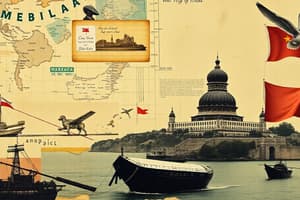Podcast
Questions and Answers
In which year was the headquarters of Gilbert and Ellice Island protectorate moved to Banaba?
In which year was the headquarters of Gilbert and Ellice Island protectorate moved to Banaba?
- 1916
- 1892
- 1896
- 1908 (correct)
Who took over the responsibility of Tokelau in 1925?
Who took over the responsibility of Tokelau in 1925?
- New Zealand (correct)
- United Kingdom
- Australia
- Germany
What was the outcome of the Tokelau Act of 1948?
What was the outcome of the Tokelau Act of 1948?
- Tokelau was sold to another country
- Tokelau was declared part of New Zealand (correct)
- Tokelau became a British colony
- Tokelau gained independence
What was the name given to the Ellice Islands after they gained independence in 1978?
What was the name given to the Ellice Islands after they gained independence in 1978?
In which year did the Gilbert Islands become independent and renamed Kiribati?
In which year did the Gilbert Islands become independent and renamed Kiribati?
What was the outcome of the separation of Gilbert and Ellice Islands in 1975?
What was the outcome of the separation of Gilbert and Ellice Islands in 1975?
Why is it important to remember the Pacific Islanders' role in the history of Kiribati, Tuvalu, and Tokelau?
Why is it important to remember the Pacific Islanders' role in the history of Kiribati, Tuvalu, and Tokelau?
What was the name of the colony created in 1916, which included Kiribati, Tuvalu, and Tokelau?
What was the name of the colony created in 1916, which included Kiribati, Tuvalu, and Tokelau?
In which year was the protectorate declared in Gilbert Islands and Ellice Islands?
In which year was the protectorate declared in Gilbert Islands and Ellice Islands?
What was the focus of the sub-strand exploring the history of the British empire in Kiribati, Tuvalu, and Tokelau?
What was the focus of the sub-strand exploring the history of the British empire in Kiribati, Tuvalu, and Tokelau?
Flashcards are hidden until you start studying
Study Notes
Introduction to Kiribati, Tuvalu, and Tokelau
- The modern-day nations of Kiribati, Tuvalu, and Tokelau comprise approximately 44 coral atolls with a combined area of 847 square kilometers.
- They have a combined population of roughly 120,608 people, similar in size to the population of Vanua Levu in 2007 (135,961).
- Kiribati is situated in the Micronesian region, while Tuvalu and Tokelau are located in the Polynesian region, sharing a mixed Micronesian and Polynesian ancestry.
Early Settlement and Culture
- Archaeological and linguistic evidence suggests that these islands were colonized between 2200 and 1000 years ago, with possible multiple waves of migration.
- The peoples of Kiribati, Tuvalu, and Tokelau were skilled navigators, frequently traveling long distances between islands for food, trade, and cultural exchanges.
- Material objects, cultural practices, oral traditions, and genealogies show similarities across the islands.
European Contact and Colonization
- Europeans began arriving in the region around the 16th century, starting with Spanish explorers, followed by British, American, and Russian expeditions.
- Whalers and traders exploited the natural resources of Kiribati, Tuvalu, and Tokelau, including copra, coconut, and phosphate.
- Some Islanders were transported overseas for cheap labor, while European missionaries converted the majority of the population to Christianity.
British Colonization
- The British established protectorates in the Gilbert and Ellice Islands, later incorporating them into the British Empire through annexation.
- The British claimed ownership of the islands, establishing colonial systems of government, including leaders (governors), military or police forces, and new buildings.
- Control of local affairs was taken from the chiefs and given to the governors, while defense and foreign affairs were determined by the British Colonial Office in London.
Timeline of Key Events
- 1892: Protectorates declared in Gilbert Islands and Ellice Islands.
- 1896: Headquarters established in Tarawa.
- 1900: Banaba (Ocean Island) protectorate declared.
- 1908: Headquarters of Gilbert and Ellice Island protectorate moved to Banaba.
- 1916: Gilbert and Ellice Islands Colony (GEIC) created, with headquarters established at Funafuti.
- 1925: New Zealand takes over responsibility of Tokelau.
- 1949: Tokelau declared part of New Zealand after Tokelau Act of 1948 was passed.
- 1972: GEIC formally separated from WPHC.
- 1975: Gilbert and Ellice Islands separated from each other.
- 1978: Ellice Islands become independent and renamed Tuvalu.
- 1979: Gilbert Islands become independent and renamed Kiribati.
Studying That Suits You
Use AI to generate personalized quizzes and flashcards to suit your learning preferences.




